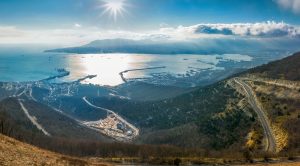In a press release on August 22, the Caspian Pipeline Consortium confirmed reports that it had suspended oil loading at two of its three single mooring points at the Black Sea terminal Yuzhnaya Ozereye, near the port of Novorossiysk.
Reuters had reported on the suspension on August 20, noting that operations at SPM-1 and SPM-2, two of the pipeline’s single mooring points at which tanker ships are filled, had been suspended due to issues identified during inspections. A source told Reuters: “CPC suspended loadings from SPM-2 since Aug. 17 due to inspection and SPM-1 has been offline since earlier this month due to the same reason.” The same source said loading at SPM-3 continued.
CPC confirmed the report with a detailed press release, which said that during inspections in August 2022 “divers discovered cracks in subsea hose attachments to buoyancy tanks.” CPC informed the manufacturer and the American Bureau of Shipping (ABS), which provides classification services to the marine, offshore, and gas industries. “These entities strongly recommended that the operation of the SPMs should be suspended until the buoyancy tanks were replaced,” the press release stated. SPM-1 was taken offline on August 5 and SPM-2 on August 17.
“The CPC Marine Terminal is temporarily loading crude oil by using only SPM-3,” the CPC said.
The CPC stressed repeatedly that the defects identified had not caused an oil spill. The press release included a diagram of how the system operates to make clear that the buoyancy tanks, which are air-filled and float between the seabed and the surface, serve to keep hoses “in a necessary configuration.” The cracks posed no threat to the surrounding environment, CPC said.
Upstream Online, an industry focused publication, reported that “[o]ne well-placed executive with inside knowledge of Caspian Pipeline told Upstream that the consortium’s Russian subsidiary has two new tanks in storage, but described the matter as one that is ‘unlikely to be resolved anytime soon.’” The publication further reported that Transneft-Service, a subsidiary of Transneft, Russia’s state-owned pipeline transport company, which provides services to the maritime terminal, “has indicated that it is unable to handle the task of replacing the damaged tanks due to a lack of sea lifting equipment, according to a source within the consortium.”
Earlier in August, CPC had announced that “[i]n view of the repairs at Tengiz field” and “the suspension of oil production at Kashagan field” in Kazakhstan, oil volumes entering the pipeline had been reduced. This may consequently soften the blow of two of three single mooring points going offline.
The latest trouble for CPC comes after a difficult year. The consortium has suspended loadings several times due to maintenance work and inspections, and in July a Russian court ordered the suspension of operations in the section of pipeline connecting Kazakhstan to the port of Novorossiysk via Russian territory. The court’s decision was quickly appealed and operations resumed, but suspicions linger that technical difficulties and environmental concerns are but convenient excuses for Russia to pressure Kazakhstan given the latter’s less-than-enthusiastic support of Moscow in its war in Ukraine.
Often overlooked is the possibility that the technical difficulties and environmental concerns surrounding CPC are valid and Russia is also taking the opportunity to pressure Kazakhstan.
SPM-1 and SPM-2 have been in operation since 2002, SPM-3 since 2014. Storms earlier this year reportedly damaged floating hoses in March, leading to one of the earlier shutdowns in operations. A German newspaper, Handelsblatt, alleged that the storms cited could not have caused the damage Russia claimed and that the entire affair was an effort to pressure Kazakhstan with regard to Ukraine.
Upstream Online, citing preliminary estimates, reported that the third single mooring point “is expected to only bear a loading rate of between 600,000 and 640,000 barrels per day,” far below the 1.2 million barrels exported per day when all three were in operation.
Kazakh President Kassym-Jomart Tokayev in July, during the brief court-ordered suspension of CPC operations, stressed the need for diversification of oil and gas export routes. But options are limited even in the best of political climates for landlocked Kazakhstan, which shares long borders with Russia and China but is far from the open ocean. “More importantly,” I wrote, “diversifying oil export routes only hitches Kazakhstan’s economy further onto an industry many see as inevitably doomed, as climate change motivates a hoped-for global shift away from fossil fuels.”

































